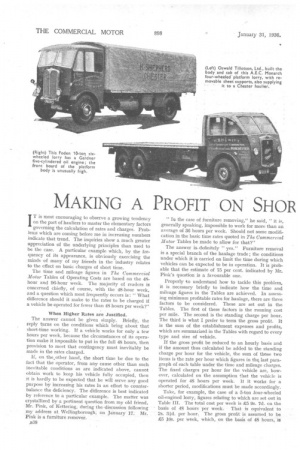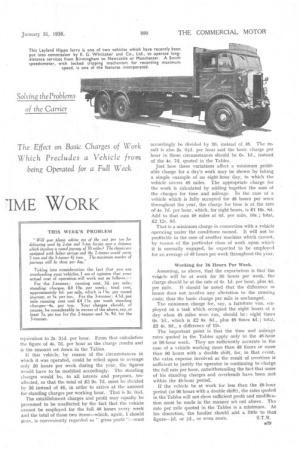MAKING A PROFIT ON SHOR IME WORK
Page 48

Page 49

If you've noticed an error in this article please click here to report it so we can fix it.
IT is most encouraging to observe a growing tendency on the part of hauliers to master the elementary factors governing the calculation of rates and charges. Problems which are coming before me in increasing numbers indicate that trend. The inquiries show a much greater appreciation of the underlying principles than used to be the case. A particular example which, by the frequency of its appearance, is obviously exercising the minds of many of my friends in the industry relates to the effect on basic charges of short time.
The time and mileage figures in The Commercial Motor Tables of Operating Costs are based on the 48hour and 96-hour week. The majority of readers is concerned chiefly, of course, with the 48-hour week, and a question which most frequently occurs is : "What difference should it make to the rates to be charged if a vehicle be operated for fewer than 48 hours per week?"
When Higher Rates are Justified.
The answer cannot be given simply. Briefly, the reply turns on the conditions which bring about that short-time working. If a vehicle works for only a few hours per week, because the circumstances of its operation make it impossible to put in the full 48 hours, then provision to meet that contingency must inevitably be made in the rates charged.
If, on the other hand, the short time be due to the fact that the operator, from any cause other than such inevitable conditions as are indicated above, cannot obtain work to keep his vehicle fully occupied, then it is hardly to be expected that he will serve any good purpose by increasing his rates in an effort to counterbalance the deficiency. The difference is best indicated by reference to a particular example. The matter was crystallized by a pertinent question from my old friend, Mr. Pink, of Kettering, during the .discussion following my address at Wellingborough; on January 17. Mr. Pink is a furniture remover.
4338
" In the case of furniture removing," he said, " it is, generally speaking, impossible to work for more than an average of 36 hours per week. Should not some modification in the basic time rates quoted in The Commercial Motor Tables be made to allow for that?"
The answer is definitely "yes." Furniture removal is a special branch of the haulage trade ; the conditions under which it is carried on limit the time during which vehicles can be expected to be in operation. It is probable that the ,estimate of 75 per cent. indicated by Mr. Pink's question is a favourable one.
Properly 'to understand how to tackle this problem, it is necessary briefly to indicate how the time and mileage figures in the Tables are achieved. In assessing minimum profitable rates for haulage, there are three factors to be considered. These are set out in the Tables. The first of these factors is the running cost per mile. The second is the standing charge per hour. The third is what I prefer to term the gross profit. It is the sum of the establishment expenses and profits, which are summarized in the Tables with regard to every type and size of vehicle.
If the gross profit be reduced to an hourly basis and if the amount thus calculated be added to the standing charge per hour for the vehicle, the sum of those two items is the rate per hour which figures in tIN last paragraph of each table under the time and mileage charges. The fixed charges per hour for the vehicle are, however, calculated on the assumption that the vehicle is operated for 48 hours per week. 11 it works for a shorter period, modifications must be made accordingly.
Take, for example, the case of a 5-ton four-wheeled oil-engined lorry, figures relating to which are set out in Table III. The total cost per week is £5 Os. 7c1. on the basis of 48 hours per week. That is equivalent to 2s. 31d. per hour. The gross profit is assumed to be• £5 10s per week, which, on the basis of 48 hours, is
equivalent to 2s. 3ld. per hour. From that calculation the figure of 4s. 7d. per hour as the charge results and is the amount set down in the Tables.
If this vehicle, by reason of the circumstances in which it was operated, could be relied upon to average only 36 hours per week during the year, the figures would have to be modified accordingly. The standing charges would be, to all intents and purposes, unaffected, so that the total of £5 9s. 7d. must be divided by 36 instead of 48, in order to arrive at the amount for standing charges per working hour. That is 3s. Old.
The establishment charges and profit may equally be presumed to be unaffected by the fact that the vehicle cannot be employed for the full 48 hours every week and the total of those two items-which, again, I should state, is conveniently regarded as " gross profit "-must accordingly be divided by 36, instead of 48. The re. suit is also 3s. Old. per hour and the basic charge per hour in those circumstances should be Gs. id., instead
of the 4s. 7d. quoted in the Tables.
Just how these variations affect a .minimum profitable charge for a day's work may be shown by taking a simple example of an eight-hour day, in which the vehicle covers 48 miles. The appropriate charge for the work is calculated by adding together the sum of the charges for time and mileage. In the case of a vehicle which is fully occupied for 48 hours per week throughout the year, the charge for time is at the rate of 4s. 7d. per hour, which, for eight hours, is £1 16s. 8d. Add to that sum 48 miles at 4d. per mile, 16s. ; total,
£2 12s. 8d.
That is a minimum charge in connection with a vehicle operating under the conditions named. It will not be profitable in the case of another machine which cannot, by reason of the particular class of work upon which it is normally engaged, be expected to be employed for an average of 48 hours per week throughout the year.
Working for 36 Hours Per Week.
Assuming, as above, that the expectation is that the vehicle will be at work for 36 hours per week, -the charge should be at the rate of Gs, id. per hour, plus 4d. per mile. It should be noted that the difference in hours does not involve any alteration to the running costs; thus the basic charge per mile is unchanged.
The minimum charge for, say, a furniture van, employed on a task which occupied the eight hours oi a day when 48 miles were run, should be : eight times Gs. id., which is £2 8s. 8d., plus 48 times 4d. ; tota,l,
£3 4s. 8d., a difference of 12s.
The important point is that the time and mileage . .
rates quoted in the Tables apply only to the 48-hour or 96-hour week. They are sufficiently accurate in the case of a vehicle working more than 48 flours or more than 96 hours with a double shift, for, in that event, the extra expense involved as the result of overtime is sufficient to justify the operator in continuing to chairge the full rate per hour, notwithstanding the fact that some of his standing charges and overheads have been met within the 48-hour period.
If the vehicle be at work for less than the 48-hour period (or 96 hours with a double shift), the rates quoLed in the Tables will not show sufficient profit and modification must be made in the manner set out above. The rate per mile quoted in the Tables is a minimum. At his discretion, the haulier should add a little to that figure-id. or id., or even more. ' S.T.R.




















































































